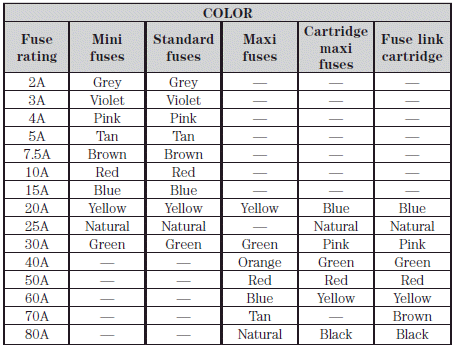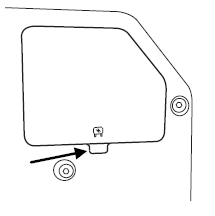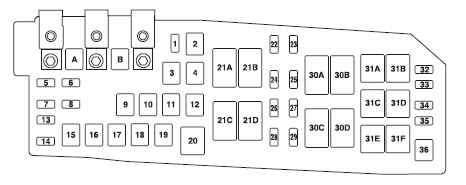Ford Escape: Fuses and relays
Fuses
If electrical components in the vehicle are not working, a fuse may have blown. Blown fuses are identified by a broken wire within the fuse. Check the appropriate fuses before replacing any electrical components.

Note: Always replace a fuse with one that has the specified amperage rating. Using a fuse with a higher amperage rating can cause severe wire damage and could start a fire.
Standard fuse amperage rating and color

Passenger compartment fuse panel
The fuse panel is located on the right-hand side of the center console, by the instrument panel.
Remove the panel cover to access the fuse cover. Press the tabs on the top and bottom of the fuse cover to remove.


The fuses are coded as follows



Power distribution box
The power distribution box is located in the engine compartment. Refer to the Identifying components in the engine compartment section of the Maintenance and Specifications chapter for the location. The power distribution box contains high-current fuses that protect your vehicle’s main electrical systems from overloads.
![]() WARNING: Always disconnect the battery before servicing high
current fuses.
WARNING: Always disconnect the battery before servicing high
current fuses.
![]() WARNING: To reduce risk of electrical shock, always replace
the cover to the Power Distribution Box before reconnecting the
battery or refilling fluid reservoirs.
WARNING: To reduce risk of electrical shock, always replace
the cover to the Power Distribution Box before reconnecting the
battery or refilling fluid reservoirs.

The high-current fuses are coded as follows.



See also:
Brakes
Brake Fluid
Check the brake fluid level by looking at the reservoir in the engine compartment.
Check that the fluid level is between the “MAX” and “MIN” lines. If the brake fluid
level is near the “MIN” line, fill it up to the “MA ...
Checking the engine oil
Engine oil is essential to the performance and
service of the engine. It is suggested that you
check the oil level at least once a week in normal
use and more often if you are on a trip or driving
in severe conditions.
Recommended Oil
Th ...

 Roadside Assistance
Roadside Assistance